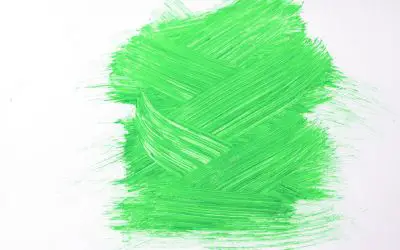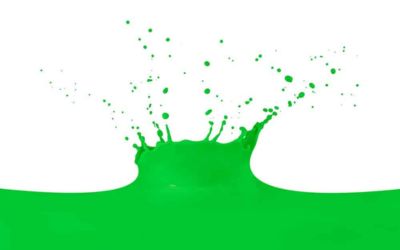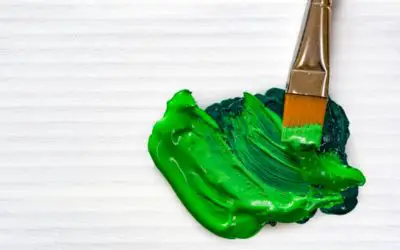Lime green is a popular branding color. The bright, bold green stands out on billboards and digital displays.
It’s also perfect for branded items like pens, water bottles, and tote bags.
Similarly, lime green is a popular color among architects and painters. For instance, it’s the color of choice for beautiful green landscapes.
Lime green also creates the impression of lush vegetation and vigorous growth.
For these reasons, every painter should learn to make lime green from scratch with different colors.
Fortunately, I’ve often mixed lime green paints and can help you make your own.
How To Make Lime Green Paint
The easiest way to make lime green is to mix yellow and blue to make green, then lighten the green color. Mix equal parts of yellow and blue paint in a mixing tray and blend the two into a uniform mixture. Then combine yellow and green mixture in small amounts to lighten it.
What is Lime Green?
Lime green is a bright, vivid green shade with the hex code #32CD32. It resembles the skin of the citrus fruit and is closely associated with nature.
Lime green promotes energy and denotes the feeling of freshness.
But beware that two colors on the hex color chart are named “lime.” The first one, lime green, #32CD32, is slightly darker.
Meanwhile, the other one is known as lime and is assigned the color code #00FF00. It’s a much brighter green tone comparable to olive and Kelly green.
Lime green comprises 19.6% red, 80.4% green, and 19.6% blue on the RBG chart.
Meanwhile, in the CMYK color space used in printing, it comprises 76% cyan, 0% magenta, 76% yellow, and 20% black.
If you’re interested, its hue angle is 120 degrees, the saturation 60.8%, and the lightness 50%. It helps to memorize these values for mixing accuracy.

The history and meaning of lime green
Lime green has been around since the 1980s. The name comes from the color of ripe citrus fruit.
It has many meanings and connotations. For instance, ancient Egyptians considered lime green a symbol of rebirth or renewal.
It also denotes strength and good health. Later it was associated with professionalism and social rank. As such, only the upper class wore lime green.
Today, lime green colors are associated with energy and youth. It also symbolizes regeneration, similar to young leaves and branches.
Lime green is also a playful color that many advertisers use to attract the younger generation.
Above all, it communicates freshness, thus common on supermarket food labels and health products.
Unsurprisingly, lime green may also denote toxicity. I believe it’s because citrus fruits are bitter. Thus, movies’ toxic potions and villains’ eyes are often lime green.
What Colors Make Lime Green?
In color theory, regular green is the product of mixing yellow and blue. So, lime green isn’t different.
It combines yellow and blue colors, but you can also make lime green by altering a green color.
That said, yellow is the main color necessary to make lime green because it produces a light and bright hue when you mix it with other colors. (Here is a guide how to make yellow paint at home)
The next most important color when making lime green is green. The best part is that you can start from any green color and work your way to lime green, though the final shades may vary.
Finally, many artists love to use blue when making lime green because it adds depth and dimension.
For instance, you should consider using blue to distinguish lime green from lime.
A warm blue tone, such as blue-green or blue-violet, produces great results. Meanwhile, Phthalo blue is cooler, producing a darker shade of lime green.
What two colors make lime green?
You can make lime green by mixing yellow and blue, with no additional colors. Often, we add white to brighten the green.
However, mixing three parts yellow and one part blue makes the perfect lime green color without needing white.
Add a few more drops of yellow to make the paint brighter, and a few more blue paint drops to make it darker.
Read also: How to Make yellow with Acrylic Paint
How to Make Lime Green with Two Primary Colors
To make lime green with two primary colors, you need plenty of yellow paint and about half as much blue. You also need a mixing tray or bucket and a stirrer.
Feel free to use a palette tray and knife when mixing tiny portions.
I use the following procedure;
- Pour sufficient yellow paint into the tray or bucket: For accuracy, use standard measuring equipment for all paint potions. You need three parts of yellow.
- Add blue paint and mix thoroughly: Add one part of blue paint to the yellow and mix thoroughly to form a uniform green color.
- Adjust the tone and shade: Add a few more drops of yellow paint to brighten the mixture. Alternatively, add a few more drops of blue to darken it.

How to Make Lime Green with One Primary Color
Yes, you can make lime green paint with just one primary color. It may not give you the perfect shade of lime green.
But it will get you through the project if you can’t find the other primary colors.
The following are step-by-step guides to making lime green with just one primary color.
Making Lime Green Color without Yellow Paint
Yellow is crucial to making green colors. At least, that’s what we gather from the color wheel. You can only make green by combining yellow with blue.
So, you must wonder how to make lime green without yellow. It’s easy if you have some raw sienna paint on hand. Even orange does the job.
If using raw sienna, mix it with Prussian blue to make a great-looking lime green color. Meanwhile, if you can only find orange paint, mix it with ultramarine blue.
Begin by pouring enough blue paint into a mixing bucket. Then gradually add the raw sienna or orange paint until you achieve the desired lime green shade.
Making Lime Green Paint without Blue Paint
Suppose you lack blue paint. In that case, you can make lime green by altering yellow paint using a few special colors.
The best combination will depend on the type of yellow paint. But I prefer cadmium yellow light as it makes wonderful lime green tones.
You can mix it with Payne’s gray or burnt umber. Both are excellent alternatives to blue paints.
This time, start by pouring enough yellow paint into the mixing bucket. Then add the gray or burnt umber paint a little at a time, stirring thoroughly to make a uniform lime green color.
How to Make the Best Lime Green Paint
Expectedly, a single primary color doesn’t make the most attractive lime green paint.
This is especially true when mixing acrylic paints. Moreover, a big challenge is finding the perfect yellow or blue acrylic paint to mix a lime green paint.
So, I’ve found that the best solution is to mix basic yellow and blue colors and alter the tone using white and black paints.
Again, purchasing pre-made gray paint from the store is more convenient. But using basic white and black provides better results.
Requirements
- Paints: You need basic yellow, blue, white, and black paints.
- Measuring equipment: Use a calibrated measuring cup.
- Mixing tools: A mixing tray/bucket and stirrer/spatula are critical.
- Paintbrush: Natural-bristled paintbrushes work best.
Mixing lime green Paint: Step-by-step guide
You can begin mixing the paints once you have all the requirements. Always wear an apron for easier cleanup.
Step 1: Measure the paint
You’ll get the best results if you measure your potions correctly and uniformly.
In this case, you need three parts of yellow paint for every part of blue paint to make green.
Indeed, you may need slightly more yellow to produce a bright lime-green color.
Begin by adding three parts of yellow paint into the mixing bucket. Then add one part of blue paint.
This will produce a yellowish-green color straightaway, making achieving the desired lime green tone easier.
However, to start with standard green, you need equal parts of yellow and blue.
This gives the perfect green. Then you can add lighter color shades to turn it to lime green. It’s a safer approach if you’re mixing paints for the first time.
Step 2: Mix the colors
Don’t underestimate the importance of proper mixing. If you mix the paints loosely, you may have undesirable streaks in your paint, damaging your project. So, mix the paints gently but thoroughly.
A specialized paint stirrer works best but a wooden spatula is just as effective. Stir in a circular motion for the best results.
Step 3: Adjust the tone as desired
Add yellow paint to warm up the dark green or add extra blue or a dash of white to cool it down.
Caution is vital at this stage though. Ideally, you want to add only a few drops at a time.
If you notice streaks, stir for a few more seconds, then check the paint again.
What Colors Make Light Green?
The easiest way to make a vibrant light green shade is by mixing lots of light yellow paint with some blue paint.
But if you want an even lighter shade, add some white to the light green paint. For instance, this makes the perfect mint green color.
If you’re struggling with what colors to mix to make mint green, a cool and bright color, orange is the perfect replacement if you don’t have any yellow paint on hand.
Use a color mixing chart to find cool shades of orange and blue for the most vibrant light green color.
However, if you have some green paint, add yellow or white to make it lighter.
The tone and shade of the light green paint will depend on the type of green you started with.
How to Make Lime Green with Acrylic Paint?
You can easily make lime green acrylic paint by mixing blue, yellow, and white paints.
The first step is to mix yellow and blue paints to form green. Then add white paint, a few drops at a time, to brighten the green color.
The step-by-step process is as follows;
Measure sufficient yellow and blue paints: Place equal portions of yellow and blue acrylic paint in a mixing tray. I often use mixing spoons to ensure equal portions. But a calibrated container works fine.
Blend the colors using a stirrer: Mixing the two produces a vivid green color, though the exact tone depends on the type of yellow and blue paint. Mix them thoroughly for a uniform mix.
Add more yellow to brighten the green paint: Add small drops as you stir until you achieve the desired green shade.
Add a little white paint for a paler shade: Add a few drops at a time, stirring gently in circular motions until you achieve a uniform mixture.

How to Use Lime Green Colors
You can use lime green in many ways. But I mainly use it to capture attention. For instance, using it alongside neutral hues creates a sharp contrast that immediately stands out.
But be warned that bright colors like lime green easily overpower the neutrals. So, use it sparingly.
Meanwhile, lime green is the perfect choice in interior design to liven up a room. For instance, you can add a splash of lime green in your living room to brighten the mood.
Similarly, a touch of lime green in the kitchen creates a sense of freshness.
What Colors Best Complement Lime Green?
Lime green combines well with multiple colors. For instance, it beautifully complements fuchsia, its complementary color on the color wheel.
Besides fuchsia, lime green works well alongside various shades of pink and purple. It also looks nice beside yellows and bright oranges.
I’ve used it next to black, too, with great effect. Alternatively, use it with other neutrals like white and tan to create contrast.
Hunter green and forest green can complement lime green well. Rich and deep tones have unique characteristics in forest green vs hunter green.
Forest green leans cooler, evoking dense greenery, while hunter green carries warmer undertones, reflecting the essence of the outdoors.
Read on: what color goes with hunter green?
FAQs
What two colors make green?
Green is the result of mixing yellow and blue. Both are primary colors, while green is a secondary color. More importantly, green comes in many shades and tones, some cool and others warm. The shade and tone depend on the type and amount of blue and yellow it contains.
How do you make neon lime green paint?
Neon lime green (also known as neon green) is a vibrant and dazzling shade of lime, with slightly less red and slightly more blue. It contains 22% red, 100% green, and 8% blue. Meanwhile, lime green contains 34% red, 66% green, and 0% blue, according to the RBG chart. To make neon green at home, use basic blue paint and a very bright shade of yellow.
How do you make lime green paint brighter?
To make lime green paint brighter, add more yellow. But do so carefully, as you cannot remove whatever you add. The best method is to add a few drops at a time, mix thoroughly, and then assess the result. Add a few drops of blue to the mixture if you feel the lime green paint is too light.
How do you make lime green without yellow?
The easiest way to make lime green without yellow is by mixing raw sienna and Prussian blue to make basic green and adding more yellow to brighten the paint. Alternatively, mix orange and ultramarine blue, then adjust the tone by adding more orange until you hit the desired brightness.
Is a lime green hue light green or a darker green?
Lime green is a lighter shade of green. It is a yellowish-green color located halfway between chartreuse green (yellow-green) and yellow on the color wheel. As a mixture of these two colors, it has a strong and vivid yellow tone.
What primary colors make green?
The two primary colors that make green are yellow and blue. The type and amount of each primary color determine the tone and shade of the resulting green color. For instance, adding more yellow makes a brighter green, while more blue makes a darker green. Green doesn’t contain red.
Is green a primary color?
No, per the color wheel, green is a secondary color. A primary color is a foundational color that you cannot derive by mixing other colors. On the other hand, secondary (and tertiary) colors are the result of mixing two primary colors. In this case, mixing blue and yellow creates green.
Summary
You can make lime green by brightening any color, from emerald to sage green and mint green.
Add drops of yellow to the green paint until you arrive at lime green.
Alternatively, you can make green by mixing equal parts of yellow and blue. Gradually add yellow or white to achieve the desired tone and shade.











Leave a Reply